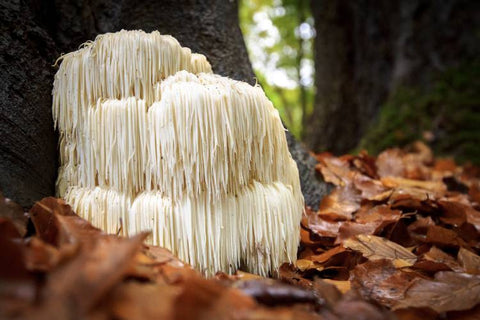For optimal Lion's Mane Mushroom growth, grow this fungi in supplemented hardwood sawdust and supplement with wheat bran at 10-20%. Higher spawn rates are effective with Lions Mane mushroom, increasing the chances that full colonization will take place. Also, Lion's Mane will grow well on the “master's mix”, which is a 50-50 hardwood sawdust and soy hulls mix hydrated to 60%.
Also known as "yamabushitake" and "Hericium erinaceus", this mushroom is now synonymous with enhanced cognition.
This is mainly due to the dozens of clinical studies proving its capabilities in improving cognition. Which is exactly why it's a key ingredient that forms Mind Lab Pro.
However, there is less information about the growth of Lion's Mane Mushroom.
As a result, we've put together this quick informative article. To provide you with everything you need to know about Lion's Mane Mushroom's growth.
Different Methods of Growing Lion's Mane Mushroom
Lion's Mane Mushroom differs from the "normal" mushrooms you'll find in your meals, in the sense that it offers nootropic benefits.
However, you'll be glad to hear that it does grow similar to any other type of edible mushroom.
For Beginners to Lion's Mane Mushroom Growing:
Those experienced in mushroom growing recommend beginners to start with a home kit. You'll be able to achieve basic results using a home kit and gain some experience right away.
After cutting your teeth with this basic method of growing Lion's Mane Mushroom, you may be comfortable progressing to a more experienced method.
For Those Experienced at Lion's Mane Mushroom Growing:
Those more experienced tend to start from commercially made Lion's Mane Mushroom spawn; although this will require you to own more tools (and be more experienced in order to succeed), you'll ultimately achieve better results than what is possible with a home kit.
For Lion's Mane Mushroom Growing Experts:
If you're not "wet behind the ears" and have grown many mushrooms, then you'll be comfortable making your own Lion's Mane Mushroom spawn from a pure culture on agar.
On agar, you'll achieve very unique growth that forms little glacier formations emerging from the initial wedge.
The obvious caveat to this growing method is that it is much more complex and difficult to achieve optimal growth of this fungi.
More Detail on Starting Your Growth with Lion's Mane Mushroom Spawn
We mentioned that hardwood sawdust supplemented with bran can be an optimal substrate for growing Lion’s Mane Mushroom.
A more complex substrate available to fungi growers for best results is the masters mix (50-50 solution of hardwood sawdust and soy hulls, hydrated to 60%).
If you want the most simple substrate to grow Lion’s Mane Mushroom on, then straw is a respectable option – although, a wood based substrate is known to be more reliable in yielding better results than straw.
Summary of Lion's Mane Mushroom Growing Instructions
Growing Lion's Mane Mushroom is a complex process that's not easy to understand. So we'll give you a summary in bullet points below...
- Add the Lion's Mane Mushroom spawn (at a spawn rate of between 10-15%) to sterilized substrate. Preferably in a Laminar Flow Hood or other clean environment.
- After inoculation, you should see a fruiting block be fully colonized between 1-2 weeks.
Lion's Mane Mushroom Growth FAQs
Q: What if my Lion's Mane Mushroom looks thin and fragile?
A: Don't worry, this species of fungi isn't as robust as others such as Reishi or Oyster.
Q: What if my fruiting block isn't fully colonized?
A: It's not uncommon to see growth filling the whole fruiting block.
Q: What's the best way to start my Lion's Mane Growth from Scratch?
A: Begin with a culture on agar, then proceed to form your grain spawn, add it to a substrate of your choice and fruit.
Q: Do you need to remove the tiny fruits from the spawn?
A: No, simply mix up the tiny fruits with the rest of your grain spawn before adding to your substrate.
